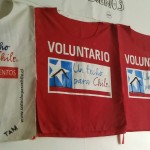Was ist eigentlich Techo? Und was machst du da eigentlich?
Techo ist das spanische Wort für Decke oder Dach. „Un techo para mi país“ bedeutet also „Ein Dach für mein Land“.
Es begann alles 1997 mit „Un techo para Chile“ als eine Gruppe junger Menschen die Wichtigkeit für sich entdeckten, die Armut in ihrem und später auch in anderen Ländern zu überkommen und begannen Transition-Häuser in den Slums zu bauen.
Das Ganze nannten sie in Kurz einfach Techo. Techo ist eine non-profit Organisation, welche in Lateinamerika und der Karibik vertreten ist. Die Gründer vertreten die Meinung, dass Armut permanent ausgerottet werden kann, wenn die Gesellschaft diese als Priorität ansieht und aktiv daran arbeitet, diese zu beseitigen.
Aus diesem Grund versucht Techo durch die enge Zusammenarbeit zwischen jungen Freiwilligen und Familien, welche in extremer Armut leben, diese Armut zu überkommen.
Um dies zu bewerkstelligen verfolgt Techo drei strategische Ziele:
- Die Förderung von Gemeindeentwicklung in den Slums: Familien in Slums arbeiten selber tatkräftig an Lösungen für ihre Situation
- Förderung von sozialer Aufmerksamkeit und Mitarbeit: Unter anderem durch das Schulen von kritischen und entschlossenen Freiwilligen, welche in Zusammenarbeit mit Familien in den Slums stehen, wobei verschiedene Akteure der Gesellschaft involviert werden.
- Politische Befürwortung: Die Politik nimmt notwendige Änderungen in der Struktur ihres Landes vor, um zu gewährleisten, dass Artmut sich nicht fortpflanzt und rapide abnimmt
Visionen:
Eine faire Gesellschaft frei von Armut, in der jeder die Möglichkeit hat seine Fähigkeiten auszubilden und seine Rechte voll auszuleben.
TECHO´S Intervention Model:
TECHO’S Community Intervention focuses on the most excluded slums of the continent. The joint work of families and young volunteers, who work to produce concrete solutions to the problematic of poverty, is the key driver of the intervention. TECHO drives a continuous community strengthening process, taking community development as the transversal axis of the intervention.
The initial phase of the Community Intervention consists of the insertion into slums and in the development of a diagnostic of the families in need. Youth volunteers have their first approach to the reality which can be seen in the slums, working in the field in order to develop a diagnosis, and to enhance the residents leadership by promoting organization, participation, and community co-responsibility in the whole process.
In the second phase, as a response to the identified needs in the community, there is an implementation and management of solutions in the areas of livability, education, labor and others that address existing problems. These solutions are developed throughout joint work between young volunteers and families, enhancing individual and collective capacities for community self-management. Young volunteers get involved in an awareness process about poverty and its causes, which leads them to act in order to generate real change.
Within this phase we emphasize the construction of transitional housing, which meets a need that is urgent and a priority in most slums. Creating a link of trust between the volunteers and the community since it is a concrete, tangible and achievable solution in the short term. The house built by TECHO is a prefabricated module of 162 square feet, built in two days, with the participation of young volunteers and families in the community. The construction generates an encounter between these two realties, promoting critical reflection and concrete proposals on how to overcome poverty. This process is done with a community approach, which promotes the organization and participation of the community.
Deepening this process of community empowerment, the community-organizing committee is implemented. This is a meeting where community leaders and youth volunteers dialogue and discuss about possible solutions to the priority problems in the slum. TECHO focuses on the implementation of education plans; work plans, such as basic skills training and micro-credit for the development of small businesses. TECHO seeks to link communities with networks to develop other programs to meet community goals and contribute to the generation of solutions.
As a third phase of the intervention, the implementation of lasting and sustainable solutions is promoted in slums, such as: regularization of property, basic services, housing, infrastructure and local development. TECHO articulates and links organized families living in slums with government institutions, so they can demand their rights.
Starting with the constant and massive hard work of young volunteers and families living in slums, TECHO denounces the exclusion and violation of rights that exists in slums, so that these problems are recognized by society and become a priority of the public agenda. Moreover, TECHO generates relevant information about slums, and seeks to be part of instances of proposal and public policy decision making, promoting structural changes that contribute to the eradication of poverty.
http://www.techo.org/en/
Das ist jetzt natürlich alles sehr theoretisch und erklärt nicht, was ich bei Techo mache. Aber ich dachte, es ist bestimmt interessant für euch zu sehen, was Techo eigentlich ist. Was ich hier genau mache, werde ich in naechster Zeit schildern!






